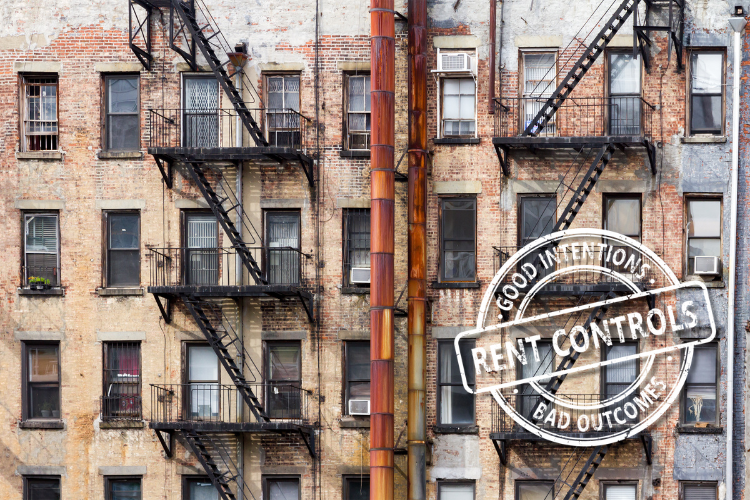
In an endeavour to address Australia's rental housing affordability crisis, there have been calls for a freeze on rents, caps on rental increases and various other forms of rent controls. While these sorts of old ideas sound like quick and workable solutions to the real distress tenants are currently experiencing, rent controls have a worldwide track record of failure.
Numerous cities across the world have dabbled with such ideas and no matter how well-intentioned and sensible rent controls might sound, these policies have routinely failed, achieving the opposite of what politicians intended and exacerbating the very issues they set out to resolve.
In this article, we look at the outcomes of different sorts of rent controls internationally and examine potential solutions to Australia's rental supply crisis.
New York: Outcome - Inequality prevails
A primary instance of rent control failure is in New York City. Since the 1940s, New York has implemented two forms of rent control: 'Rent Control' and 'Rent Stabilisation.' Under these measures, annual rent increases are restricted, often resulting in rents significantly lower than market rates.
However, the result has been a disincentive for landlords to maintain or improve their properties. The limited returns on their investments do not justify the cost of significant renovations. This has led to an ageing and deteriorating housing stock. Furthermore, it has created a two-tiered system, with some tenants having access to artificially low rents and others, particularly newcomers, forced to pay steep market rates. This inequality is stark evidence of rent control's inability to deliver fair access to affordable housing.
Sweden: Outcome - Chronic housing shortage
Stockholm, Sweden, provides another example. The city has a rigid rent control system with the commendable aim of ensuring everyone has access to affordable housing. Yet the result has been counterproductive. The system has led to a chronic housing shortage, with waiting lists for a controlled rental apartment stretching into decades. It has also birthed a black market for rental contracts, leading to further inequity and social division.
Paris - Fewer rentals and intensified demand
In France, a more recent attempt at rent control took place in 2015, when Paris introduced the 'Encadrement des loyers' (Rent regulation) policy. Unfortunately, this also resulted in unintended side effects. As landlords were not permitted to increase rents above a specified index, many chose to sell their properties rather than lease them. This led to a decrease in available rental stock and, paradoxically, increased rents due to intensified demand. This policy was subsequently repealed in 2017 due to its inefficacy.
Berlin - Exacerbated housing shortages
Similarly, Berlin's recent experiment with a five-year rent freeze, introduced in 2020, had negative consequences. Designed to alleviate housing affordability issues, the policy instead deterred investment in the housing sector, leading to a slowing in new construction and exacerbating the city's housing shortage. In 2021, Germany's federal constitutional court overturned the rent cap, deeming it unconstitutional, highlighting the legal complexities rent control measures can present.
So why does rent control consistently fail?
Firstly, it distorts the housing market. By setting rents below market rates, it disincentivises both property improvements and new development. This leads to a shortage of quality rental properties, as seen in New York and Berlin.
Secondly, rent control often leads to an inefficient allocation of housing. Without the price mechanism to allocate resources, people may consume more housing than needed, as seen with 'empty-nesters' occupying large rent-controlled apartments in New York City. On the other side, those desperate for housing, like young professionals or migrant workers, are left out in the cold.
Thirdly, rent control tends to create a divide between 'insiders' – those lucky enough to secure a rent-controlled home – and 'outsiders' – typically newcomers who bear the brunt of decreased housing availability and increased market rates. This has been evident in Stockholm and New York City.
Lastly, it often overlooks more effective solutions. Experts argue that the root cause of Australia's high rents is a lack of supply. Rather than artificially suppressing rents, the focus should be on easing zoning regulations, streamlining approval processes, and incentivising development to boost housing supply.
The solution is building more homes
While the idea of rent control breeds policies born of good intentions, the international evidence demonstrates consistent failure. Rent control does not merely fall short of its objectives; it often exacerbates the problems it intends to solve, from deteriorating housing conditions to market inefficiencies and social inequities.
In the battle for affordable housing, Australia's policymakers need to refocus on supply-side solutions. Rent control, is simply not the panacea it appears to be.
-
5 months agoHow to Win the Rental Application Race
-
11 months agoCAN ASSIST CHARITY AUCTION
-
about 1 year agoKeep The Kids Entertained For The Easter Holidays

